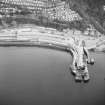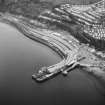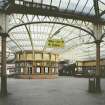Following the launch of trove.scot in February 2025 we are now planning the retiral of some of our webservices. Canmore will be switched off on 24th June 2025. Information about the closure can be found on the HES website: Retiral of HES web services | Historic Environment Scotland
Wemyss Bay Railway Station And Pier
Pier (19th Century), Railway Station (20th Century), Railway Station (19th Century)
Site Name Wemyss Bay Railway Station And Pier
Classification Pier (19th Century), Railway Station (20th Century), Railway Station (19th Century)
Alternative Name(s) Wemyss Bay Station; Wemyss Bay Pier
Canmore ID 68123
Site Number NS16NE 12
NGR NS 19338 68544
Datum OSGB36 - NGR
Permalink http://canmore.org.uk/site/68123
First 100 images shown. See the Collections panel (below) for a link to all digital images.
- Council Inverclyde
- Parish Inverkip
- Former Region Strathclyde
- Former District Inverclyde
- Former County Renfrewshire
NS16NE 12.00 1935 6860
Wemyss Bay Station [NAT]
Pier [NAT] (at NS 1918 6854)
Ferry Terminal (Vehicular) [NAT] (at NS 1925 6851)
OS 1:10,000 map, 1992.
NS16NE 12.01 19379 68566 Station House
NS16NE 12.02 19386 68583 SW Station Cottages
NS16NE 12.03 1914 6855 to 1929 6853 Pier
NS16NE 12.04 19387 68589 Central Station Cottages
NS16NE 12.05 19391 68596 NE Station Cottages
(Wemyss Bay Station and Pier; location cited as NS 193 685). Rebuilt 1903 by the Caledonian Rly., architect James Miller and engineer Donald Mathieson. Noted as one of the finest stations of its period. A platform terminus with glazed awnings over the platform. There is a circular booking office with steel ribs radiating from it to support a circular glazed roof. The approach from the street is through a single-storey, stone and harl building with a clock tower in similar style. There is a gently sloping ramp to the pier, with glazed sides and roof.
J R Hume 1976.
Wemyss Bay Station (1903-4) is a combination of several buildings, all designed by the prolific James Miller for the Caledonian Rly with a striped clocktower. Internally, everything is roofed in a bright, light, fully-glazed lattice steel structure which curves fluently not only in section but in plan also. Around the central semi-circular booking office shallow-arched canopies slide out like sinuous octopus tentacles over arcaded platforms and down the ramped hall leading to the pier and the Rothesay ferry. One of the finest surviving pieces of railway architecture in Scotland.
F A Walker 1986.
This terminal station on the Wemyss Bay branch of the (former) Caledonian Rly. was opened on 15 May 1865 by the Greenock and Wemyss Bay Rly. It remains in regular passenger use as part of the Glasgow suburban system; the station and its branch line have been electrified.
Information from RCAHMS (RJCM), 29 December 1997.
R V J Butt 1995.
Construction (1865)
Original station and pier built.
Construction (1903)
Rebuild of railway station.
Publication Account (1985)
Wemyss Bay station and its pier were renowned to generations of Glaswegians as the railway terminus for their annual trip 'doon the watter' to Rothesay on the island of Bute.
Originally opened in 1865 by the Wemyss Bay Railway Company, the station was completely rebuilt in 1903 by its new owners, the Caledonian Railway Company, and is regarded as one of the finest stations of its period. From the outside it is distinguished by its clock-tower and from the inside by the centrally placed booking office from which radiate the steel ribs for the glazed roof.
Information from ‘Exploring Scotland’s Heritage: The Clyde Estuary and Central Region’, (1985).
Project (2007)
This project was undertaken to input site information listed in 'Civil engineering heritage: Scotland - Lowlands and Borders' by R Paxton and J Shipway, 2007.
Publication Account (2007)
Wemyss Bay Station and Pier, built in 1865, formed the terminus of a branch of the Caledonian Railway which
served the towns on the south coast of the Clyde. This resort was the steamer terminal for much of the pleasure
sailing on the Clyde operated from both Gourock and Wemyss Bay by the Caledonian Railway fleet.
To meet an increasing demand from holidaymakers the station was rebuilt in 1903 to a design by James Miller
and Donald Matheson with an elegant roof of light ironwork and glass, conveying the impression of airy spaciousness.
A covered way was provided to the steamer berths on the pier so that convenient access was possible in all weathers.
The station was refurbished in 1994 at a cost of £1.8 m and still serves the ferry to Rothesay and the Isle of Bute
and summer excursions. It is one of Britain’s finest stations and was considered by the Railway Heritage Trust as one of
the most remarkable conservation projects to which it had contributed.
R Paxton and J Shipway 2007
Reproduced from 'Civil Engineering heritage: Scotland - Lowlands and Borders' with kind permission of Thomas Telford Publishers.
Note (October 2017)
The Allure of Steam
Perhaps it is something to do with the sensory experience of rail. The whistle blowing, smoke billowing out, the metallic strain of each cast component, the smell and feel of soot and coal. In any case, the steam train is guaranteed to excite as if in the presence of a wild animal. Rare as it is today, I inherited an enthusiasm for steam from my father who remembers the morning train to school some 65 years ago. Fundamental though steam was to our industry and economy, it was a role in the leisure industry that helped to take Scotland’s workers away from the stresses and strains of a daily grind, and brought about the construction of some of the finest stations.
The curving, sinuous station at Wemyss Bay, on the Firth of Clyde, represents one of these gateways to leisure. From here hundreds of tourists from Glasgow and the rest of Scotland emerged onto the platforms and headed for the steamers to the island of Bute, ‘doon the water’. The design is stunning. Captured from the air it still looks futuristic more than 110 years after construction. The way it melds delicate cast iron metalwork with massive columns and hundreds upon hundreds of tessellated panes of glass is enriched by the circular concourse, from where train platforms head west, and a gently curving and descending timber walkway that tempts one ‘to the steamers’. Outside, the building creates a more bizarre chocolate box visage sporting numerous miniature gables and a fine 60ft clock tower.
An Engineering Marvel
The current building was constructed in 1903 and replaced an earlier station of 1865 which itself was a substantial Georgian building of two storeys. The original specification of the new building survives providing a huge amount of detail on each element of its construction. Sandstone was to come from local quarries and the slate from Ballachulish or Wales. All the steel and ironwork was to be made in Britain to ensure quality and it was to be coated in boiled linseed oil before four coats of paint were applied, to protect it from the sea air. While some materials were local, others were sourced from far afield for the same reasons of quality: white pine from the Baltic was used liberally while the best Quebec red pine was specified for timbers in contact with stone, where rot was more likely.
This detailed specification and unusual design were the work of two men; Donald Matheson, chief engineer of the Caledonian Railway; and James Miller, architect. Either with the Railway or working for his own practice, Miller designed nearly 70 railway stations in Scotland and the pair also worked together on Glasgow Central station, successfully combining engineering, aesthetics, passenger flow and economy. Their achievement at Wemyss Bay still functions well today after electrification in 1967 and a major restoration in 1994, informed by those detailed specifications of 90 years before.
The holidaymakers who disembarked at Wemyss Bay were often heading to the island of Bute, one of the lesser known and easier to reach gems in Scotland’s island family. By the mid-1950s Bute was still attracting 400,000 visitors a year, though the number was to plummet over successive decades as international holidays and car journeys became more affordable. Nowadays Bute is witnessing something of a resurgence with restoration and improvement in Rothesay bringing it back to its heyday. An article in the Guardian newspaper describes it as ‘the Scottish island that could just have it all’, and the trip there by rail and sea from Glasgow is certainly part of its magic.
Sources :
Boyne, S, Hall, D and Gallagher, C 2000 ‘The Fall and Rise of Peripherality: Tourism and Restructuring on Bute’ in Brown, F and Hall, D (eds) Tourism in Peripheral Areas, 101-113.
Clar, A J C 2001 Caley to the Coast or Rothesay by Wemyss Bay, Oakwood Press.
George Geddes, Archaeologist, Survey and Recording














































































































































































































